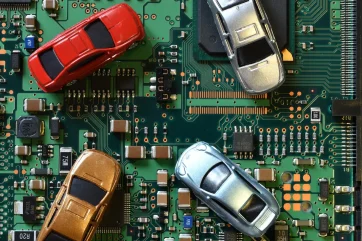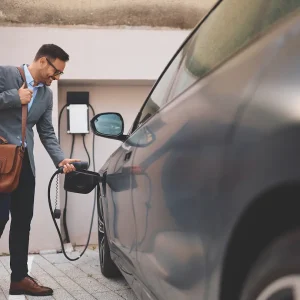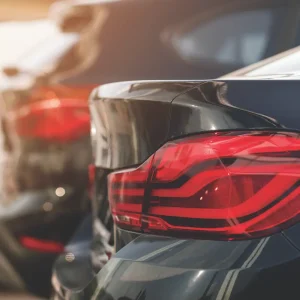
The semiconductor shortage grabbed most of the headlines, but there were plenty of other factors at play in the post-pandemic new-vehicle shortage era. The 2022 Fukushima earthquake reportedly impacted production at local factories, including Toyota’s and Nissan’s, while severe flooding in Malaysia in late 2021 and early 2022 was also said to have affected local suppliers. Covid and lockdowns were not entirely out of the international picture and, after the natural disasters, the war in Ukraine added a shortage of wiring harnesses in early 2022.
The industrial impact of all the above was the biggest dearth of new vehicles in living memory, and SMMT figures show a 3.1m (31.4%) drop in new car registrations in the four years to 2024 compared with the four years to 2020 – equivalent to removing more than a year of sales.
Where new cars go, used cars follow. We are now close to five years on from the start of the pandemic and, although the chip shortage arguably began simultaneously, its effects were felt most acutely in 2021 and 2022. The latter year was the lowest for UK new car sales this century at 1.61m.
“We’re nearly at the bottom of the used car supply,” says Dylan Setterfield, head of forecast strategy at Cap HPI, “it’s about the middle of the year, towards the end of the first half, when we’re actually there.
“From that point onwards, it starts to steadily increase, and by the time we get to the beginning of 2026, we’ll start to see more [used] cars on the market than we are today.”
Fleet and, unsurprisingly, diesel sales have seen the biggest proportionate losses. SMMT data for the four years to 2024 shows a collective 33% reduction in fleet registrations and 77% for diesels. Petrol also took a hit but it was a lesser 30.4%, while BEVs and PHEVs were obviously well on the rise, up 1,041.2% and 149.72% respectively, albeit from a much lower base.
Diesel’s fall is no surprise, but fleets might be, given the strength of the sector’s current position in the new car market, but it can be explained by manufacturer tactics at the height of the new vehicle shortages.
“What we saw at the end of 2021 and into 2022 was a lot of manufacturers prioritising retail at the expense of fleet, even to the extent of actually cancelling orders and switching production” adds Setterfield, “at one stage, about two-thirds of that total shortfall was from leasing and daily rental and still, even now, after we’ve had a bit of an improvement in fleet and a reduction in retail, it’s a big chunk of the total [shortage].”
“If you look at diesels over the last five years, 322,000 of them were registered in 2020,” says Philip Nothard insight director at Cox Automotive, “that’s a four-to-five-year-old car now, and there were 123,000 registered in 2024. That availability is worsening as you go forward.”
Mixed market
It means the comfortable predictability of your ex-fleet, diesel Mondeo is gone for good. It might not have had the best residual values in the business, but you could almost set your watch by how much it would be worth after three years. For dealers, stock is now at its lowest ebb and, if they are not already, they are going to have to get comfortable with selling a mixture of used cars, irrespective of what powers them.
On the plus side, the market’s laws of supply and demand mean whatever fleets and retailers do sell should go for strong money. Online auction firm Autorola predicted in January that used car prices would rise this year, as a direct impact of 2022’s exceptionally low new-car registrations. It expects a shortfall of between 500,000 and 700,000 vehicles in 2025.
“Prices are only moving one way, and that’s gradually up,” says Autorola’s head of sales, Chris Timms, “it’s not massively steep, but we certainly noticed that a car that was £16,000 last week [the week beginning 6 January] is now £16,250 this week, so we would expect that to continue.”
The firm also reported price increases in the final quarter of last year, which bucked the usual end-of-year slowdown, set the stage for 2025 and supports anecdotal reports that some major fleets and rental companies – which traditionally ease or halt defleets towards the end of the year – continued selling to take advantage of a strong market.
Values are only expected to increase by so much, though. While prices are more palatable than they were in the early part of the decade, used cars are still relatively expensive, and pockets are only so deep, especially with the cost of living the way it is.
“Because of the increases that we saw in 2021, used cars are already quite expensive, certainly in historic terms, so there isn’t as much potential for prices to go up,” explains Setterfield.
Even with the lack of supply, buyers are still thinking twice about ex-fleet vehicles that need work. Clean cars and vans are, as always, selling quickly and for the best money, but those in need of repairs are not flying through the halls, often due to the time it can take to acquire the parts.
“You may see a vehicle go through the auction hall that’s £700 less than you would pay for a clean car,” says Timms, “but that might rely on a particular part that could take two or three weeks to turn up… and that vehicle is more likely to go unsold.”
“There’s a bigger difference in terms of condition at the moment than we’ve seen in previous years,” adds Setterfield, “clean cars, anything that’s ready to retail, those are really sought after. There’s a lot of competition for them. Anything that’s not in good condition is much harder to sell.”
Timms advised fleets to consider smart repairs and light refurbishments as part of their remarketing programmes: “I think the technical term is grade enhancement,” he explains, “if you want to move it from a [NAMA] grade three to a two, or a two to one, we see this work best when there’s a calculation that says ‘if we can do up to £150 of work and we can guarantee that it increases the grade,’ then we would typically expect our vendors to carry out that work.”
As we explained previously, refurbishment capacity has improved since Cazoo’s closure, and more facilities have opened to the wider market. However, everybody still says bodyshop slots and technicians are about as available as three-year-old used cars, which means that fleets are sometimes forced to offload their vehicles in whatever condition they find them.
The bigger they are, the harder they fall
While used car prices are looking sturdy for the rest of this year, Cap HPI believes an eventual increase in volumes, likely in 2026, could cause values to fall at a greater-than-usual rate. It is not predicting a market crash, rather a drop relative to the number of vehicles available at the time, and in recognition of the cost of second-hand cars, which remains higher than it was pre-pandemic.
“We think there is potential for bigger decreases in prices when the volumes do start to increase again,” says Setterfield. “Often what happens is, it’s not the absolute level of cars in the marketplace – it’s ‘how different is the number of vehicles that I can see today compared to last week or last month?’ That tends to be a bigger driver of the pricing behaviour, certainly for the trade.
“There’s a limited amount of elasticity in the marketplace. Whenever there is a recession or a real downturn in consumer behaviour, it doesn’t stop people buying cars, because they need them to get to work or look after relatives or whatever it happens to be – but they might buy something higher mileage, older or smaller compared to what they might have bought if everything was rosy.”
Supported by:






